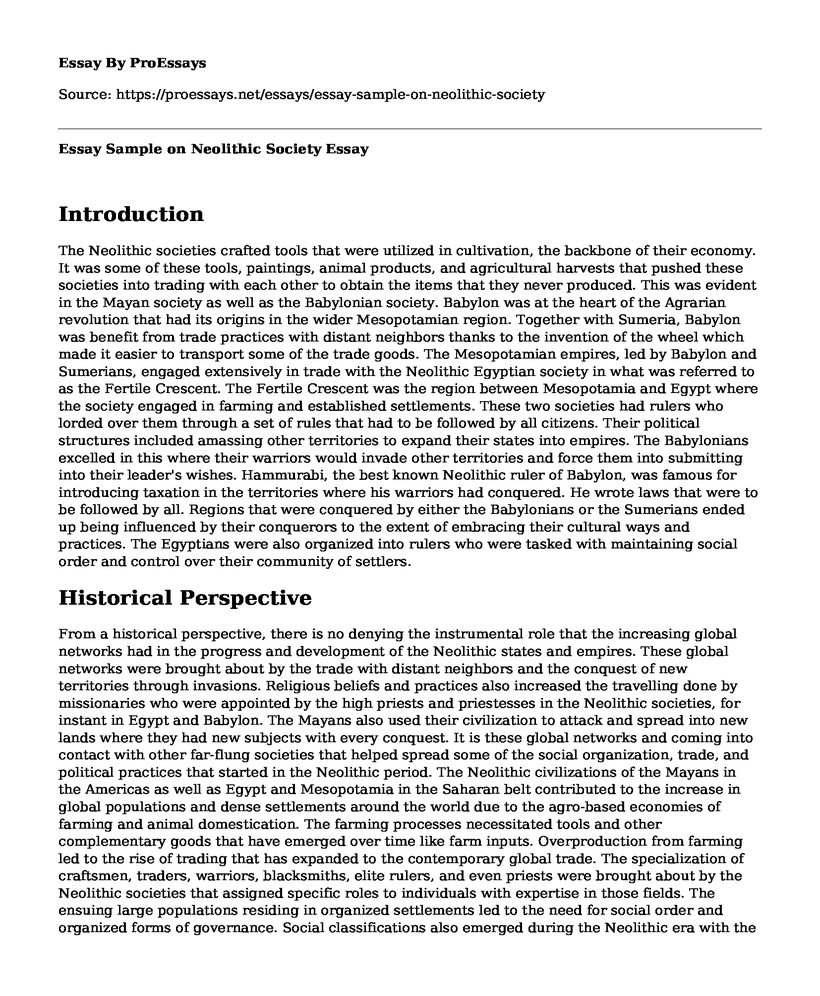Introduction
The Neolithic societies crafted tools that were utilized in cultivation, the backbone of their economy. It was some of these tools, paintings, animal products, and agricultural harvests that pushed these societies into trading with each other to obtain the items that they never produced. This was evident in the Mayan society as well as the Babylonian society. Babylon was at the heart of the Agrarian revolution that had its origins in the wider Mesopotamian region. Together with Sumeria, Babylon was benefit from trade practices with distant neighbors thanks to the invention of the wheel which made it easier to transport some of the trade goods. The Mesopotamian empires, led by Babylon and Sumerians, engaged extensively in trade with the Neolithic Egyptian society in what was referred to as the Fertile Crescent. The Fertile Crescent was the region between Mesopotamia and Egypt where the society engaged in farming and established settlements. These two societies had rulers who lorded over them through a set of rules that had to be followed by all citizens. Their political structures included amassing other territories to expand their states into empires. The Babylonians excelled in this where their warriors would invade other territories and force them into submitting into their leader's wishes. Hammurabi, the best known Neolithic ruler of Babylon, was famous for introducing taxation in the territories where his warriors had conquered. He wrote laws that were to be followed by all. Regions that were conquered by either the Babylonians or the Sumerians ended up being influenced by their conquerors to the extent of embracing their cultural ways and practices. The Egyptians were also organized into rulers who were tasked with maintaining social order and control over their community of settlers.
Historical Perspective
From a historical perspective, there is no denying the instrumental role that the increasing global networks had in the progress and development of the Neolithic states and empires. These global networks were brought about by the trade with distant neighbors and the conquest of new territories through invasions. Religious beliefs and practices also increased the travelling done by missionaries who were appointed by the high priests and priestesses in the Neolithic societies, for instant in Egypt and Babylon. The Mayans also used their civilization to attack and spread into new lands where they had new subjects with every conquest. It is these global networks and coming into contact with other far-flung societies that helped spread some of the social organization, trade, and political practices that started in the Neolithic period. The Neolithic civilizations of the Mayans in the Americas as well as Egypt and Mesopotamia in the Saharan belt contributed to the increase in global populations and dense settlements around the world due to the agro-based economies of farming and animal domestication. The farming processes necessitated tools and other complementary goods that have emerged over time like farm inputs. Overproduction from farming led to the rise of trading that has expanded to the contemporary global trade. The specialization of craftsmen, traders, warriors, blacksmiths, elite rulers, and even priests were brought about by the Neolithic societies that assigned specific roles to individuals with expertise in those fields. The ensuing large populations residing in organized settlements led to the need for social order and organized forms of governance. Social classifications also emerged during the Neolithic era with the elite forming the ruling class that exploited their subjects for labor and taxes.
Conclusion
As can be deducted from the above discussion, the Neolithic humans built societies, states, and empires during the period that lasted until 1500 CE with a view of advancing their race in a civilized way. Their creations had a mammoth impact on the subsequent generations with the most notable being the formation of governments and political organization. The Neolithic period also brought with it the trading of commodities and commerce in general, not to mention the specialization and division of labor that was practiced in these farming societies. This historical essay has made use of the Mayan, Egyptian, and Babylonian Neolithic societies to show the progressive political, social, and economic developments that the period experienced.
Bibliography
Hodder, Ian (Ed.). Religion at Work in a Neolithic Society: Vital Matters. Cambridge: Cambridge University Press, 2014.
Kuijt, Ian (Ed.). Life in Neolithic Farming Communities: Social Organization, Identity, and Differentiation. New York: Kluwer Academic, 2012.
Magee, Peter. The Archaeology of Prehistoric Arabia: Adaptation and Social Formation from the Neolithic to the Iron Age. Cambridge: Cambridge University Press, 2014.
Parmington, Alexander. Space and Sculpture in the Classic Maya City. Cambridge: Cambridge University Press, 2011.
Rich, Claudius James. Narrative of a Journey to the Site of Babylon in 1811: And Other Memoirs. Cambridge: Cambridge University Press, 2014.
Shea, John Joseph. Stone Tools in the Paleolithic and Neolithic...
Cite this page
Essay Sample on Neolithic Society. (2022, Nov 16). Retrieved from https://proessays.net/essays/essay-sample-on-neolithic-society
If you are the original author of this essay and no longer wish to have it published on the ProEssays website, please click below to request its removal:
- Whether Blacks Have Higher Rates of Hypertension as Compared to White Races?
- Essay Sample on Discourse Community and a Writing Community
- Research Paper on The Effects of Positive Affect and Nature Connectedness on Life Satisfaction
- Essay on How Walt Disney Ruined Our Love Lives: The Impact on Modern Romantic Relationships
- Dominant Culture: White Anglo-Saxon Protestants in American Society - Research Paper
- Essay Example on Race, Ethnicity: 3 Sociological Perspectives
- Case Study Sample on Ethical Decision-Making: Models to Guide Critical Thinking







